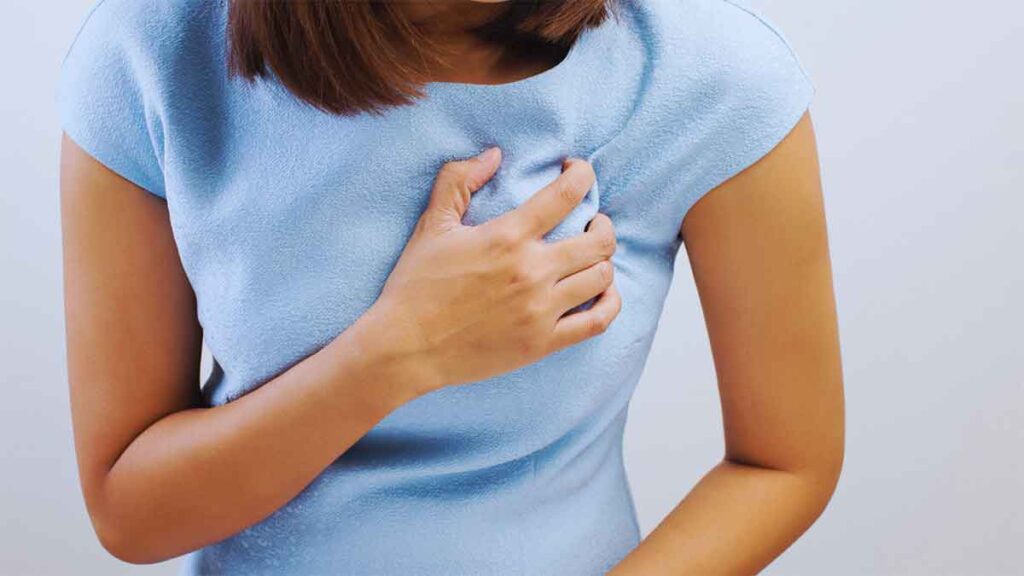Breast pain is a common concern among women of all ages. While it can be unsettling, breast pain does not always indicate a serious medical condition.
There are many reasons why breast pain occurs, ranging from hormonal changes to breast infections and even certain medications. Identifying the underlying cause is key to finding relief and ensuring your breast health remains a priority.
Why Do You Have Breast Pain?
Breast pain, also known as mastalgia, is a common concern that affects women of all ages. For some, it comes and goes with hormonal changes, while others experience persistent discomfort that interferes with daily life. While breast pain can be unsettling, it is important to remember that most cases are not linked to serious health conditions. Identifying the type of pain and its underlying causes can help determine the next steps, whether that means simple lifestyle adjustments or seeking a professional evaluation.
Breast pain presents in different ways. Some women describe it as a dull, aching sensation, while others experience sharp, burning, or throbbing discomfort. The pain may be localized to one area or spread across both breasts, with varying intensity. In some cases, it comes and goes, while in others, it lingers for extended periods. One of the most useful ways to classify breast pain is by determining whether it is cyclic or non-cyclic. Each type has different triggers and characteristics, which can provide insight into what might be causing your discomfort.
Cyclic vs. Non-Cyclic Breast Pain
Breast pain is categorized into two primary types: cyclic and non-cyclic. Cyclic breast pain is related to hormonal fluctuations and typically follows a predictable pattern, while non-cyclic breast pain is often linked to structural changes, infections, or external factors. Recognizing which type of pain you have can help you manage symptoms more effectively and determine if further evaluation is necessary.
Cyclic Breast Pain
Cyclic breast pain is the most common form of breast discomfort, primarily affecting women in their reproductive years. It is directly tied to hormonal changes that occur throughout the menstrual cycle, which influence breast tissue sensitivity and fluid retention.
This type of pain typically occurs in the days leading up to menstruation and improves once the period begins. It is often felt in both breasts, especially in the upper outer areas, and is described as a heavy, tender, or swollen sensation rather than a sharp or stabbing pain. Many women also notice breast lumpiness that fluctuates with their cycle, which is usually normal.
Although cyclic breast pain is usually harmless, it can become uncomfortable or interfere with daily activities. If the pain is severe, persistent, or worsening, consulting a gynecologist can help rule out other potential causes and explore treatment options.
Non-Cyclic Breast Pain
Non-cyclic breast pain is less common but can still be concerning. Unlike cyclic pain, it is not linked to the menstrual cycle and may occur sporadically or persist over time. This type of pain is more likely to be localized, affecting one breast or a specific area rather than both. It is often described as sharp, burning, or stabbing, and may become more noticeable with movement or pressure on the affected area.
There are many possible causes of non-cyclic breast pain, including infections, cysts, past surgeries, injuries, or nerve irritation. In some cases, discomfort may stem from muscle strain in the chest wall, which can mimic breast pain. Certain medications, such as hormone therapy or antidepressants, may also contribute to increased breast sensitivity. A gynecologist can assess the symptoms and determine whether additional testing or treatment is needed.
Common Breast Conditions That Cause Pain
While hormonal fluctuations and pregnancy-related changes are among the most common causes of breast pain, certain breast conditions can also lead to discomfort. Some conditions are benign and temporary, while others may require medical evaluation and treatment.
Understanding the underlying causes of breast pain helps in distinguishing between normal cyclical discomfort and symptoms that may indicate a breast health concern. If you experience persistent, localized, or worsening pain, consulting a gynecologist can clarify the situation and guide you toward the appropriate treatment.
Fibrocystic Breast Changes and Cysts
Fibrocystic breast changes are one of the most common causes of breast pain, particularly among women of reproductive age. These changes occur when breast tissue becomes lumpy, swollen, or tender, often fluctuating with hormonal shifts throughout the menstrual cycle.
What Causes Fibrocystic Breasts?
The exact cause is not fully understood, but fibrocystic changes are believed to be linked to hormonal fluctuations, particularly estrogen and progesterone levels. These hormones stimulate the breast ducts and lobules, leading to tissue overgrowth and lumps or fluid-filled cysts.
This condition is noncancerous and does not increase the risk of breast cancer, but it can cause noticeable discomfort, lumpiness, and breast heaviness.
Symptoms of Fibrocystic Breast Changes
- Lumpiness or thickened breast tissue that feels rope-like or grainy.
- Tenderness and swelling, especially before menstruation.
- Breast pain that fluctuates with the menstrual cycle and typically improves after your period.
- Cysts (fluid-filled sacs) that feel smooth, round, and movable under the skin.
Many women notice that their breast texture changes throughout the month, with symptoms peaking in the days leading up to their period. If a lump appears and does not shrink or disappear after menstruation, it is essential to get it checked by an OBGYN specialist for further evaluation.
Regular breast self-exams and clinical breast evaluations are encouraged to monitor any new or changing lumps. If a lump persists, feels firm, or is accompanied by unusual nipple discharge, schedule an appointment for a comprehensive breast exam.
Infections and Inflammatory Conditions
Breast infections and inflammatory conditions can also lead to sudden or persistent breast pain. These conditions are more common in breastfeeding women, but they can also occur in non-lactating individuals.
Mastitis: A Common Breast Infection
Mastitis is an infection of the breast tissue that often develops when bacteria enter the breast through cracked or sore nipples. It is most common during breastfeeding when milk ducts become clogged or inflamed, allowing bacteria to multiply.
Symptoms of Mastitis:
- Pain, swelling, and warmth in a specific area of the breast.
- Redness or a firm, tender lump.
- Fever and flu-like symptoms, including chills and fatigue.
- Burning sensation during breastfeeding (if lactating).
If left untreated, mastitis can worsen into a breast abscess, which may require drainage. Early treatment is important to prevent complications.
Hormonal Changes and Menstrual Cycle-Related Pain
Hormonal fluctuations are a primary cause of breast tenderness and discomfort for many women. The natural rise and fall of estrogen and progesterone throughout the menstrual cycle influence breast tissue, leading to sensations of swelling, heaviness, or soreness.
Understanding how hormones impact breast sensitivity can help differentiate normal menstrual-related discomfort from symptoms that may need medical evaluation. If breast pain before your period feels excessively intense, persistent, or unusually different from your typical cycle, consulting an OBGYN can help rule out underlying issues and provide relief strategies.
How Estrogen and Progesterone Affect Breast Sensitivity
Breast tissue is highly responsive to hormonal changes, particularly estrogen and progesterone, which fluctuate throughout the menstrual cycle. These hormones prepare the body for potential pregnancy, influencing various structures within the breast:
- Estrogen stimulates ductal growth: As estrogen levels rise in the first half of the cycle (follicular phase), the milk ducts within the breast expand, leading to mild swelling and tenderness. Some women may notice an increase in breast fullness during this time.
- Progesterone causes glandular enlargement: In the second half of the cycle (luteal phase), progesterone levels increase, causing the milk glands to expand and retain fluid. This can make breasts feel heavier, swollen, and more sensitive in the days leading up to menstruation.
- Increased blood flow and fluid retention: The combination of estrogen and progesterone can improve blood circulation to the breast tissue, contributing to tenderness and a slightly engorged feeling.
These hormonal fluctuations explain why cyclic breast pain—pain that follows a pattern related to the menstrual cycle—typically occurs in a week or two before menstruation and resolves once the period begins. The discomfort is often bilateral (affecting both breasts) and may feel dull, achy, or heavy rather than sharp or localized.
For most women, this type of breast pain is harmless and subsides naturally. However, if the pain worsens, lasts beyond your cycle, or feels significantly different from your usual premenstrual discomfort, it is best to consult a gynecologist for a thorough evaluation.
Why Some Women Experience Breast Pain Before Their Period
Not all women experience the same degree of premenstrual breast pain, and some may notice more pronounced symptoms than others. Several factors contribute to why breast pain varies from person to person:
1. Hormonal Imbalances
Some women have higher-than-average levels of estrogen or lower levels of progesterone, which can intensify breast sensitivity. Conditions such as polycystic ovary syndrome (PCOS) or thyroid disorders may also contribute to hormone fluctuations that amplify breast pain before menstruation.
2. Fluid Retention and Swelling
Increased water retention in the days before your period can cause breast tissue to swell, making it feel tight, full, or lumpy. Some women may also feel a mild burning or tingling sensation, especially if the swelling is significant.
Factors that can worsen fluid retention include:
- High salt intake, which promotes water retention.
- Dehydration leads the body to hold onto excess fluids.
- Caffeine consumption can increase breast tenderness in sensitive individuals.
3. Birth Control and Hormone Therapy
Oral contraceptives, hormone replacement therapy, and intrauterine devices (IUDs) that release hormones can sometimes increase breast tenderness before menstruation. Some women are more sensitive to synthetic hormones, leading to more noticeable premenstrual breast discomfort while adjusting to a new birth control method.
If birth control significantly worsens your breast pain, an OBGYN specialist can help evaluate whether an alternative method may be better suited for your body.
Taking Control of Your Breast Health
Understanding what is normal and when to seek medical advice is key to maintaining breast health. While most breast pain is harmless, staying proactive ensures peace of mind and early detection of potential concerns.
How Regular Checkups with an OBGYN Can Help
Seeing a gynecologist regularly ensures that any changes in your breast health are monitored. Annual exams allow for early detection, giving you access to care before small concerns become bigger issues.
Whether it’s a routine checkup or a diagnostic screening, staying informed and proactive is the best approach to long-term health. At Gwinnett OBGYN, our board-certified OBGYN specialists provide expert breast exams, diagnostic screenings, and compassionate care tailored to your needs.
Schedule an appointment with Gwinnett OBGYN today to speak with a trusted gynecologist specialist and take the next step toward better breast health and peace of mind.



